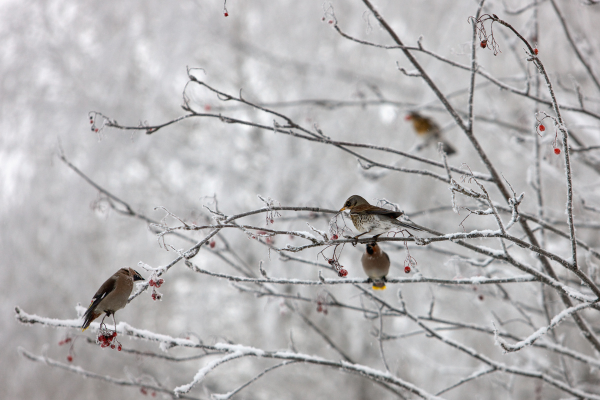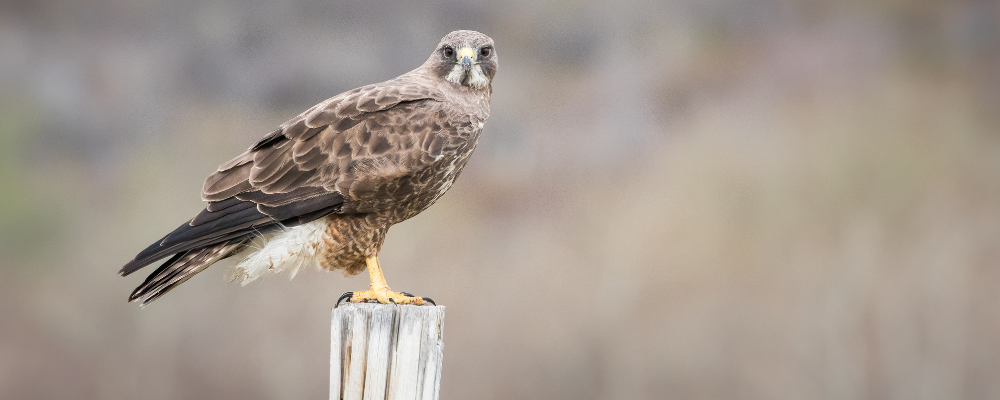Taking Care of Birds in Winter

What can be more cheerful than seeing a bare tree full of bright Cardinals in your backyard after a heavy snow in January? Even though this scene might make a perfect picture postcard, the birds themselves may be struggling to survive. A loss of native habitat poses a challenge for our native birds, but there are some simple things you can do to increase their chances this winter.
Every year I evaluate my yard looking for ways to improve the native habitat for birds and other wild creatures. If you watch the birds in your yard, you will notice that the population changes with the seasons. Many of the birds we see in the summer are migratory, and head south for winter. Others, like Blue Jays, Mockingbirds, Cardinals, and Eastern Blue Birds stay here all year. A third group like American Goldfinch and Cedar Waxwings are here only during winter.
As you know, winter in North Central Texas can be harsh, with freezing temperatures, high winds, bare trees, dormant vegetation, and often dry conditions. Although nature has equipped the wild critters in your yard with survival skills to help them get through winter, most of them could use your help.
Basically, birds need four things to survive: food, water, warmth, and protection from predators. They need an almost constant supply of calories to maintain their body heat due to high metabolism. They need clean water, which can be difficult when temperatures drop below freezing. Even though their feathers are a very effective insulator when fluffed up, they still experience a high rate of heat loss due to the cold, windy conditions of winter. Because of this, they need protected roosting and nesting places.
There are several things you can do to help make their struggle a bit easier. Some of these are quite simple while others will require some planning and effort. Landscape your yard with plants that provide native food sources such as seeds, nuts, and berries. Provide a dependable source of clean water such as a bird bath, a fountain, or a pond. And provide natural roosting and nesting areas that will protect birds from both the weather and predators.
There are many native and adaptive plants that provide a natural source of food for wildlife. By planting a variety of these in your yard you can provide adequate food for birds during warm weather. During winter when natural food sources are scarce, put out bird feeders to provide additional nutrition. During warmer months, bird feeders are not necessary and may even be harmful, making them dependent on the free handout.
Some birds that primarily prefer a diet of insects will resort to seeds and berries in the winter. A good example of this is the Northern Mockingbird. In summer it feeds primarily on insects, but in winter when most insects are dormant, it dines on yaupon, possumhaw, polk weed, and juniper berries.
Most seed-eating birds love black sunflower seed. This can easily be provided using a platform feeder. Unless you want to feed all the squirrels in the neighborhood, you will need to equip it with a squirrel guard. Also, often the larger birds like White-winged Doves and Crows, will swarm the feeder and drive away the smaller birds. This can be prevented by installing a “bully cage,” which allows the smaller birds in but keeps the larger birds out.
Place your feeders so you can enjoy the bird activity from your windows, but not too close. It is estimated that millions of birds are killed each year by flying into windows, Please don’t attract them to your windows by the location of your feeders. Also, place the feeders away from cover where cats or other predators can lie in wait for them.

Even though it’s obvious that water is critical for survival during the hot, dry, scorching days of summer; it is easy to overlook the need during winter. Our winters can be dry, and natural water sources often dry up. During freezing weather the water may freeze over, preventing the birds from getting a drink. A bird bath or other water feature can provide a constant source of water. Flowing water or a drip in the bath can keep the water moving and may prevent freezing up during a mild freeze, but it may be necessary to install a heater to keep the water moving during a hard freeze.
Birds need places to perch, roost, and find respite from high winds and rain storms. This can be provided by evergreen shrubs and trees. If possible, let the underbrush grow in certain parts of your yard. This will provide a place for roosting and nesting that is safe from predators and sheltered from the weather. In urban areas you may not be able to do this if you have restrictions, but do so if you can. Birds and other wildlife will reward you for your efforts.
Another great source of shelter is a brush pile. This is especially attractive to our winter sparrows. There are about thirteen species of sparrows that come to North Texas to spend the winter. Do not confuse these with House Sparrows, which are not native to North America, and are harmful to some of our highly desirable species like Eastern Bluebird and Purple Martin. Find a spot in your landscape where you can pile old tree limbs, clippings, weeds and other organic stuff; and let it accumulate. The brush will provide refuge from predators and shelter during winter weather. Eventually it will decompose and make a nice compost.
Dead and standing trees are very important in the wildlife landscape. If you have a dead tree, unless it is threatening people or structures, let it stand. It provides great perches for birds to rest, preen and look for prey. It also will provide a great source of food for woodpeckers as they scavenge for borers and other insects.
You may have noticed that most birds are very jumpy and erratic with movement that is quite unpredictable. There’s a very good reason for this. An incautious bird is soon a dead bird. In fact, many birds do not survive their first year. There’s always something trying to eat them. Domestic cats may be their worst enemy. If you have cats, please take precautions to ensure that they are not a threat to the birds. Then, of course, there are bird’s natural enemies, like hawks, foxes, and snakes. These are all a part of the natural environment, and must have their food, too. Nature must maintain a balance.

Habitat loss is no doubt the biggest threat to our wildlife. Unnatural hazards in our neighborhoods create unique challenges such as windows, domestic cats, automobiles, and artificial lighting. These hazards can upset the natural balance that our birds depend upon. That’s why the birds need our help. Fortunately, there are simple landscape changes we can make in our own yards to improve their chances. You can significantly help our wild friends survive, while enjoying the beauty and antics of nature.
